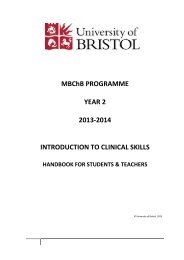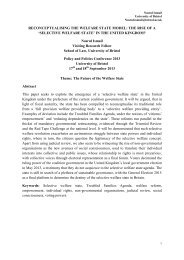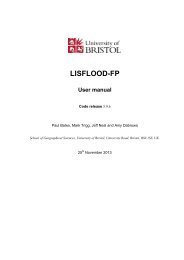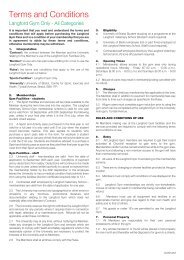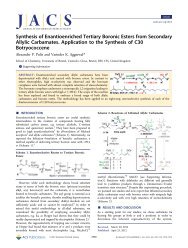AAPA abstracts - University of Bristol
AAPA abstracts - University of Bristol
AAPA abstracts - University of Bristol
You also want an ePaper? Increase the reach of your titles
YUMPU automatically turns print PDFs into web optimized ePapers that Google loves.
104 <strong>AAPA</strong> ABSTRACTS<br />
Fracture analyse <strong>of</strong> historical long<br />
bones.<br />
NADINE CARLICHI 1 , FLORIAN<br />
FISCHER 2 , KRISTIN VON HEYKING 1 ,<br />
and GISELA GRUPE 1 . 1 LMU Biocenter,<br />
Department Biology I, Anthropology<br />
and Human Genetics, Ludwig-Maximilians-<strong>University</strong><br />
<strong>of</strong> Munich, Planegg-<br />
Martinsried, Germany,<br />
2<br />
Institut <strong>of</strong><br />
Legal Medicine <strong>of</strong> Munich, Germany.<br />
In the course <strong>of</strong> archaeological excavations<br />
traumatic injuries are <strong>of</strong>ten found,<br />
especially fractures, which can be<br />
detected relatively well in human bone.<br />
Fractures are defined as a disruption <strong>of</strong><br />
the continuity <strong>of</strong> a skeletal element,<br />
exceeding the maximum limits <strong>of</strong> the<br />
structures elasticity under the forces <strong>of</strong><br />
pressure, tension or bending. The identification<br />
<strong>of</strong> such lesions leads to important<br />
information about the interaction<br />
<strong>of</strong> a prehistoric population with warfare,<br />
interpersonal violence and other<br />
aspects <strong>of</strong> daily life (Aufderheide and<br />
Rodriguez-Martin 1998).<br />
Because <strong>of</strong> a long exposure to the burial<br />
environment or through the impact <strong>of</strong><br />
different forces, e.g.: root predation, low<br />
pH-value or mechanical deformation by<br />
the soil, some fractures cannot be recognized<br />
as such (Wahl 2001).<br />
In most published studies, a warlike<br />
past is in the main focus. Skeletal series-covering<br />
fracture types are seldom<br />
determined and compared with each<br />
other.<br />
The object <strong>of</strong> this study is a comparison<br />
between modern clinical data from the<br />
Institute for Legal Medicine in Munich<br />
and ancient fracture types, to check<br />
whether certain fracture patterns are<br />
phenomena <strong>of</strong> recent times or whether<br />
fracture types occur intertemporally<br />
and irrespective <strong>of</strong> the prevalent forces.<br />
For this, long bones from different medieval,<br />
spatiotemporally defined skeletal<br />
series at the Bavarian State Collection<br />
for Anthropology and Paleoanatomy<br />
with notation <strong>of</strong> a trauma were selected.<br />
Because most fractures have healed<br />
well, a method consisting <strong>of</strong> morphological<br />
analysis, x-ray and CT-scan is used<br />
to make the fracture line visible and to<br />
identify the fracture type.<br />
Isotopic nutritional ecology at<br />
Ngogo, Kibale National Park,<br />
Uganda.<br />
BRYCE CARLSON and JOHN KINGS-<br />
TON. Department <strong>of</strong> Anthropology,<br />
Emory <strong>University</strong>.<br />
Despite the acknowledged significance <strong>of</strong><br />
dietary shifts in human evolution,<br />
anthropologists today are only marginally<br />
closer to understanding dietary<br />
niches <strong>of</strong> early hominin lineages. The<br />
use<strong>of</strong>stableisotopicanalysestoreconstruct<br />
paleodiets has largely been limited<br />
to gross distinctions <strong>of</strong> C3 versus C4 consumption<br />
and hampered by a poor<br />
understanding <strong>of</strong> ecological factors con-<br />
American Journal <strong>of</strong> Physical Anthropology<br />
trolling isotopic variability. This project<br />
is the first to utilize bulk as well as compound<br />
specific isotopic analyses within a<br />
forested East African environment resident<br />
to over 7 species <strong>of</strong> large and small<br />
bodied primates. As such, this project<br />
seeks to create a methodological baseline<br />
from which to begin refining previous<br />
and future analyses <strong>of</strong> tissue d 13 C and<br />
d 15 N in the reconstruction <strong>of</strong> early hominin<br />
dietary patterns.<br />
Collection <strong>of</strong> plants from Ngogo, Kibale<br />
National Park in Uganda, spanning<br />
both wet and dry seasons resulted in<br />
over 400 individual samples from 40 different<br />
species. Sampling included those<br />
foods most commonly consumed by<br />
endemic chimpanzees, as well as a number<br />
<strong>of</strong> less consumed species to ensure<br />
representation by each class <strong>of</strong> food<br />
items (including flowers, pith, cambium,<br />
leaves, fruit, vertebrate prey, etc). Bulk<br />
and compound specific isotopic analyses<br />
were then conducted on nested groups<br />
<strong>of</strong> samples to tease apart the origins <strong>of</strong><br />
amino acid and bulk level variability.<br />
Analyses revealed seasonal, as well as<br />
intra- and inter-species differences in<br />
d 13 C and d 15 N that inform our understanding<br />
<strong>of</strong> isotopic variability in an<br />
East African tropical forest habitat and<br />
provide a foundation for interpreting<br />
isotopic signatures <strong>of</strong> early hominin material.<br />
This study was funded by the National<br />
Science Foundation, grant number<br />
0925785, and The Leakey Foundation.<br />
Linearity in the real world – an<br />
experimental assessment <strong>of</strong> nonlinearity<br />
in terrestrial locomotion.<br />
KRISTIAN J. CARLSON 1,2 . 1 Institute<br />
for Human Evolution, <strong>University</strong> <strong>of</strong> the<br />
Witwatersrand, 2 Department <strong>of</strong> Anthropology,<br />
Indiana <strong>University</strong>.<br />
Cross-sectional geometric properties <strong>of</strong><br />
long bones are widely applied in inferring<br />
primate behavioral repertoires. Amongst<br />
hominins, these are particularly useful<br />
for reconstructing mobility patterns. Experimental<br />
studies <strong>of</strong> long bone loads<br />
characterizing locomotor activities, however,<br />
demonstrate disconnect between<br />
measured and theoretical loads predicted<br />
from bone morphology. This complicates<br />
population-level comparisons. The lack <strong>of</strong><br />
a consistent definition for mobility, likely<br />
a multifactorial phenomen, further complicates<br />
these comparisons.<br />
In order to contribute towards a consensus<br />
definition <strong>of</strong> mobility, I address one<br />
specific factor – non-linear locomotion.<br />
Following an instantaneous focal sampling<br />
protocol, locomotor behavior was<br />
documented multiple times per day for<br />
individuals. Custom-designed cages accentuated<br />
zig-zag (condition 1) or linear locomotion<br />
(condition 2), while control mice<br />
inhabited standard laboratory cages. At<br />
the termination <strong>of</strong> the experiment, limb<br />
bones were harvested for microCT scanning<br />
and structural analysis. Combining<br />
results from a previous experiment using<br />
growing BALB/cByJ female mice (n 5<br />
30), and a second experiment (n 5 35)<br />
using growing C57BL/6J female mice, I<br />
compare structural effects <strong>of</strong> movement<br />
regimes amongst them, and by lineage.<br />
Femoral cross-sectional properties (e.g.,<br />
cortical areas, second moments <strong>of</strong> area,<br />
polar moment <strong>of</strong> area, shape ratios) and<br />
activity pr<strong>of</strong>iles were compared. C57BL/<br />
6J groups differed amongst themselves in<br />
activity level more than BALB/cByJ<br />
groups. Zig-zag mice tended to have more<br />
elliptical diaphyses in both groups. Linear<br />
and control mice differed less <strong>of</strong>ten in<br />
many properties. Distinctiveness <strong>of</strong><br />
shapes in zig-zag mice across the lineages<br />
supports the idea that non-linear movements<br />
(e.g., turning) likely have a recognizable<br />
effect on long bone structure.<br />
Supported by the NYCOM Office <strong>of</strong><br />
Research.<br />
Ramifications <strong>of</strong> insufficient DHA:<br />
evidence from studies during pregnancy<br />
and infancy.<br />
SUSAN E. CARLSON. Department <strong>of</strong><br />
Dietetics and Nutrition, <strong>University</strong> <strong>of</strong><br />
Kansas Medical Center, Kansas City,<br />
KS.<br />
The 22 carbon n-3 fatty acid, DHA,<br />
accumulates rapidly in forebrain beginning<br />
around the 24th week <strong>of</strong> gestation<br />
and the concentration increases at a<br />
near linear rate through the first 2<br />
years <strong>of</strong> age. Although the increase in<br />
brain DHA in the last trimester is quite<br />
dramatic, it is small compared to accretion<br />
in a) adipose tissue <strong>of</strong> the fetus and<br />
b) forebrain in the first 2 years <strong>of</strong> postnatal<br />
life. The DHA that accumulates in<br />
adipose tissue during fetal life is<br />
believed to be a reservoir for postnatal<br />
DHA needs <strong>of</strong> the newborn; e.g., the<br />
amount <strong>of</strong> DHA as a percent <strong>of</strong> total<br />
fatty acids in adipose tissue declines<br />
rapidly after birth. Studies <strong>of</strong> postnatally<br />
administered DHA have asked,’’ Is<br />
DHA a conditionally essential nutrient<br />
for infants or can adequate amounts be<br />
synthesized from its essential fatty acid<br />
precursor, a-linolenic acid? ‘‘ Not surprisingly,<br />
given the inability <strong>of</strong> the preterm<br />
fetus to accumulate normal brain<br />
or adipose tissue DHA, DHA supplementation<br />
has been shown to benefit<br />
cortical visual acuity and outcomes<br />
related to cognition. Results <strong>of</strong> term<br />
supplementation studies are more variable,<br />
possibly reflecting differences in<br />
maternal DHA status due to dietary<br />
intake <strong>of</strong> DHA and genetic differences<br />
in DHA biosynthesis by both mother<br />
and fetus/infant [individual alleles for<br />
fatty acid desaturases (FADS1/2) have<br />
been correlated with 20 and 22 carbon<br />
PUFA status]. There are only a few<br />
DHA supplementation trials during<br />
pregnancy, however, numerous observational<br />
studies find benefits <strong>of</strong> higher<br />
maternal DHA intake.<br />
The author’s Phase III randomized clinical<br />
trials (RCTs) are funded by NICHD<br />
and Mead Johnson Nutrition.




